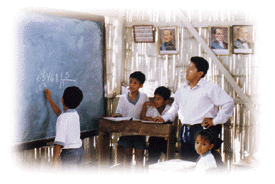Impact on Students

Besides breaching the beliefs that stem from the constitution, prayer in public schools will only cause hardships for our students. School children are particularly susceptible to peer pressure and other forms of confrontation. Instituting prayer in public schools is extremely invasive to student’s rights to have no religious pressure. When prayer is introduced to a public school curriculum it will only cause conflict with students. This is especially true with students who find particular prayers, or just prayer in general, offensive, and they cannot express their disapproval by "walking away" or verbally objecting.
One example of this type of problem is evident in the U. S. Supreme Court case Abingdon Township v. Schempp. Just one short year after the Engel v. Vitale case, the Supreme Court was faced with another case regarding religion in public schools. A Pennsylvania school began each morning with a reading from the Bible, from which students could be excused upon parental request. With disgust over this practice, the Schempps, who were Unitarian, challenged this activity. Mr. Schempp argued that he did not have his children excused from the readings because he did not want to "expose them to the ridicule or distrust of their classmates and teachers," and he did not want their absence to be "interpreted as un-American and possibly as immoral" (Alley, School 120). A second example of this type of problem occured in the U. S. Supreme Court Case, McCollum v. Champaign Board of Education when various teachers were brought in to the school to teach classes about religion during school hours. According to the Supreme Court decision, this "released time" program was held to be unconstitutional because there was obvious pressure upon the children to attend these functions (Voluntary 469).
Since the United States is mostly Christian, most prayers in school will represent Christian values and impose them on our youth, which will lead to students of minority religions feeling uncomfortable praying with students of different beliefs. Public schools include children of so many beliefs, races, and economic backgrounds that the state should not even attempt to make all of them pray a single prayer. Any prayer instituted in school would then have to be cross cultural, but then any prayer that broad would be so watered down that it would be meaningless. How could you compose such a generic prayer that would include beliefs of Catholics, Protestants, Baptists, Buddhists, Muslims, Atheists, and others without expressing contradicting notions? Such a task could not be accomplished. You would neither be able to call any prayer instituted by a teacher or any public official to be voluntary because religious liberty means that you choose when and how to expose yourself to religious practices. Schooling is necessary for youngsters, and if public schooling is the only option for financially strapped families, then restrictions on religious programs can only infringe on student’s rights to free religious expression (Carney 26).
According to the Analysis of Supreme Court Cases by the Library of Congress, students maintain the right to engage in daily prayer rituals at anytime, distribute religious literature, talk to students about religious belief, wear religious clothing and symbols, and discuss religion in class and in reports (974). By allowing student initiated school prayer, the government is not imposing on a student’s right to free speech in any way. Government supported school prayer, however, is unconstitutional because it inhibits students rights to have any type of religious or non-religious beliefs. Such activity should not be allowed in a state-funded environment such as a public school.
Introduction ![]() Separation of
Church and State
Separation of
Church and State ![]() Supreme Court
Cases
Supreme Court
Cases ![]() Impact on
Students
Impact on
Students ![]() Conclusion
Conclusion ![]() Bibliography
Bibliography ![]() Other Links
Other Links